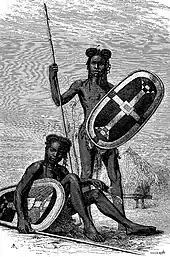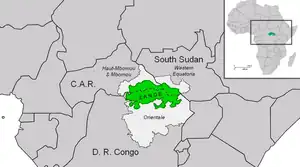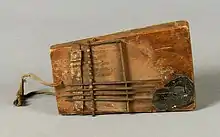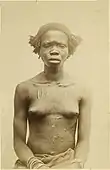 Azande men with shields, harp, between 1877 and 1880. | |
| Total population | |
|---|---|
| 3.8 million at end of 20th century[1] | |
| Regions with significant populations | |
| 96,500 | |
| 2,061,000 | |
| 1,040,000 | |
| Languages | |
| Pa-Zande • Bangala • English • French • Lingala • Sango • Juba Arabic | |
| Religion | |
| Christianity • African Traditional Religion | |
| Related ethnic groups | |
| Nzakara people • Geme people • Barambu people • Pambia people • Other Ubangian peoples | |
The Azande are an ethnic group in Central Africa speaking the Zande languages (whose classification is uncertain). They live in the south-eastern part of the Central African Republic, the north-eastern part of the Democratic Republic of the Congo, and the south-central and south-western parts of South Sudan.[2] [3] The Congolese Azande live in Orientale Province along the Uele River; Isiro, Dungu, Kisangani and Duruma. The Central African Azande live in the districts of Rafaï, Bangasu and Obo. The Azande of South Sudan live in Central, Western Equatoria and Western Bahr al-Ghazal States, Yei, Maridi, Yambio, Tombura, Deim Zubeir, Wau Town and Momoi.
History
The Azande were believed to be formed by a military conquest during the first half of the 18th century. They were led by two dynasties that differed in origin and political strategy. The Vungara clan created most of the political, linguistic, and cultural parts. A non-Zande dynasty, the Bandia, expanded into northern Zaire and adopted some of the Zande customs.[4] In the early 19th century, the Bandia people ruled over the Vungara and the two groups became the Azande people. They lived in the savannas of what is now the southeastern part of Central African Republic. After the death of a king, the king's sons would fight for succession. The losing son would often establish kingdoms in neighboring regions, making the Azande Kingdom spread eastward and northward. Sudanese raids halted some of northward expansion later in the 19th century. As a consequence of European colonialism in the 19th century, the territory inhabited by the Azande was divided by Belgium, France, and Anglo-Egyptian Sudan.[5]
During his travels in the late 1870s, the Austrian photographer Richard Buchta took photographs of Azande that were used in European publications about Central Africa and constitute an important source of historical documentation.[6]
The Azande are considered to be one of the last ethnic groups to move into the region and were the only group that did not engage in an agro-pastoral lifestyle.[7] The Azande were considered skilled metalworkers in pre-colonial Sudan. Although the Azande did not originate in South Sudan, many other ethnic groups in the region also migrated into the region though the Azande’s late arrival has made them the target of some cross-ethnic animosity.
In 2015, conflict between the Azande and the Dinka ethnic group in the city of Yambio, Western Equatoria state led SPLA chief Paul Malong Awan to instruct soldiers to open fire on anyone insubordinate to his directives.[8] Awan implemented plans to soothe the situation in the region as ethnic tensions flared.
Amnesty International documented evidence of war crimes in 2021 as warring factions from the larger Dinka and Nuer ethnic groups attacked the Azande and Balanda Bviri ethnic groups from the Western Equatoria region.[9] Additional conflict broke out between Azande and Balanda factions as well.
Zande Scheme
In 1938, the Governor of Sudan ordered a survey of areas of modern-day South Sudan by Dr. J.D. Tothill, who previously oversaw agriculture in British Uganda, to evaluate the region’s potential for agricultural production.[10] The Azande region was selected for agricultural experimentation because it was designated as food secure. The British got tribal and Indigenous leaders to support the plan and attempted to run a propaganda campaign to urge the local community to abide by the Azande Scheme. The Scheme was organized to reduce reliance on imports and promote self-sufficiency. It emphasized growth and processing of valuable commodities for local use and export. The exports were supposed to pay for necessary imports. Originally hailed as a success by many scholars,[11] the program largely failed, partly because of the Azande's relative isolation to trading ports and lack of sufficient infrastructure to bring in the machinery required to build a finishing and manufacturing sector in such a rural area. Additionally, the roads were not of adequate quality for exports and the British government deemed the prices too steep to justify. The project required extensive human and monetary capital investment which the British government realized was too substantial. Because of this isolation, many Azande have moved to towns closer to major roads.[12]
Though the plan emphasized cotton, crops that maintained soil health were promoted and land was allocated specifically for palm oil production to assure substantial yield and quality.[10] The plan included cattle farming which the British identified as deficient prior to the Zande Scheme.[11] Experimental agriculture was introduced to eventually reduce cotton as the region’s primary crop. Coupled with the agricultural development, the British built industrial infrastructure further north near Khartoum to process the cotton and export it. Though the plan eventually failed, its ambitions were to turn Sudan into a wealthy state by the 1970s and was initially regarded as being on track to reach or exceed the goal.[11]
The plan’s failures were attributed not only to lack of resources but failure to adequately train the population to shift from older agricultural methods.[13] An immediate retrospective of the plan’s failure pointed to lack of bureaucratic oversight in enforcing the tenets of the plan, leading to homestead mismanagement. When entrenched methods of farming proved increasingly difficult to dissuade, experimental farming techniques required additional investment to compensate for inefficiencies. These additional costs played a role in leading the British to abandon the project.
Name

The word Azande means "the people who possess much land", and refers to their history as conquering warriors. Variant spellings include Zande, Azande, Azandeh, Azende, Bazende,[2] Zandeh, A-Zandeh, and Sandeh. Another name is Adio.
The onomatopoeic name Niam-Niam suggests cannibalism and was sometimes used for the Azande people.[14] It was possibly circulated intentionally to create fear among ethnic groups in the Azande's period of regional conquest.[14] The name shows up on 19th-century maps of Southern Sudan as is now considered pejorative.[14] First used by other tribes in southern Sudan, it was later adopted by Westerners, who frequently used it to refer to the Azande in the 18th and early 19th century. The British Museum website indicates as spelling variants Niam niam, Niam-niam, Nyam nyam, Nyam-nyam, Neam Nam, Neam Neam, Neam-Nam, and Neam-Neam.[2]
The plant species Impatiens niamniamensis is named after the Azande people.
Demographics

The Azande population is spread over three Central African countries: South Sudan, the Democratic Republic of the Congo and the Central African Republic. Azande Kingdom extends from the fringes of the South-central and Southwest Upper basin of South Sudan to the semitropical rain forests in Congo, and into the Central African Republic.
Estimates of Azande speakers reported in SIL Ethnologue are 730,000 in the Democratic Republic of the Congo, 62,000 in the Central African Republic and 350,000 in South Sudan.[15]
Settlements
The types of houses that the Azande built were made from mud and grass, which they framed around wooden poles and thatched with grass. Each household was built around a courtyard so that they can gather and converse with each other. Adjacent to these courtyards were kitchen gardens that were for plants that did not require large scale farming such as pineapples and mangos.[16]
In order to implement the Zande Scheme, the British sought to establish new settlements in the region, centered around cotton ginneries.[10] In order to improve access throughout the region to encourage commutes between settlements in the region, the British contracted Azande laborers to modernize 100 miles of roadway and construct bridges to traverse rivers. The British also constructed agricultural training facilities and experimental farms in Yambio and pushed urbanization schemes in the region.
The British resettled 60,000 Azande people into newly constructed settlements of 50 families named gbarias.[11] These settlements helped the British facilitate oversight concerning their plan’s implementation as well as the development of academic and medical institutions. Families were given 25-40 acres of land and answered to a gbaria chief.
Social and political organizations
The Azande were organized into chiefdoms that can also be called kingdoms. The Avongara were the nobility and passed it down through their lineage. Chiefs had many roles within the chiefdoms such as being military, economic, and political leaders. All the unmarried men were laborers and warriors.[16]
Within the chiefdoms clan affiliation was not stressed as important at the local level. They had "local groups" that were similar to "political organizations".[16]
Colonial records described the Azande as “individualists' ' who, prior to villagization under the Zande Scheme, lived together in family groups on homesteads with women carrying out agricultural duties.[13]
Sleeping sickness caused internal migrations and social reorganization among the Zande people, leading them to coalesce around paths of travel, which meant that they exhausted soil nutrients near thoroughfares.[13]
Agriculture
The Azande are mainly small-scale farmers. Crops include maize, rice, groundnuts (also known as peanuts), sesame, cassava and sweet potatoes. Fruits grown in the area include mangos, oranges, bananas, pineapples, and also sugar cane. Zandeland is also full of palm oil and sesame. From 1998 to 2001, Zande agriculture was boosted since World Vision International bought agricultural produce.
The British colonial authority noted in 1948 that the importation of mangoes into the Azande region from the Congo around the turn of the 20th century.[17] In the ensuing years, mangoes grew to prominence being planted throughout the Zande territory with "avenues" of trees surrounding many of the roads in the region around the middle of the 20th century.[18]
Since then, the Azande have hunted and farmed millet, sorghum, and corn. Major cash crops include cassava and peanuts.[5]
The region in which the Azande live has two seasons. During the rainy season the women and men both help get food from the river. Women help with the fishing in dammed streams and shallow pools collecting fish, snakes, and crustaceans. Men make and set up traps in the river to help with the collection of food. Another food that the Azande collect and eat is termites which are their favorites.[16]
_men.jpg.webp)
Language and literature
The Azande speak Zande, which they call Pa-Zande, which has an estimated 1.1 million speakers.[15] Zande is also used to refer to related languages in addition to Azande itself, including Adio, Barambu, Apambia, Geme, Kpatiri and Nzakara. Recorded Zande literature is mostly oral, some of it published by missionaries in the early 20th century, and some of it translated in the 1960s.[19]
Visual culture and music

As in other African societies, applied arts, artifacts, music and oral literature are key elements of Zande culture. They are most famously known for their throwing knives, called the "shongo". These show the skill of Zande metal workers with their curved and multi-bladed features. Their visual art includes sculptures made from wood or clay. Many of these represent important animals or ancestors. Zande also have created drums and thumb pianos, called sansa, that sometimes looked like people, animals, and abstract figures. These instruments were used at celebrations like marriages and community dances.[20]
Traditional beliefs
Religion
Most Azande formerly practised a traditional African religion, but this has been supplanted to a large extent by Christianity. Their traditional religion involves belief in Mbori, an omnipotent god.[20] They practice magic, oracles, and witchcraft in order to solve their everyday problems.[21] However, the late-nineteenth century marked the beginning of many Zande converting to Christianity. 85 percent of Azande consider themselves Christian, while 15 percent follow their traditional religion. More than half of Azande identify as Roman Catholic.[20]
Early missionaries to the Azande found it difficult to draw comparisons between Christian beliefs and the spiritual belief in “Mbori” who created the universe though did not play the role of God in Christianity.[22] Folk stories of “tricksters” have helped establish a basis for social conduct and the consequences of violating social expectations. The Azande trickster, Ture, is representative of poor decisions and rash actions and serves as a deterrent against similar actions in the community.
The Azande use oracles in their religious traditions, with many different oracles serving unique purposes and carrying varying levels of repute within the larger community.[22] The poison oracle in particular carried a reputation as being an important oracle to the Azande as that oracle, reserved exclusively for men, kept oral traditions and stories alive.
Witchcraft

Other traditional beliefs include magic and witchcraft. Among the Azande, witchcraft, or mangu, is believed to be an inherited black fluid in the belly which leads a fairly autonomous existence, and has power to perform bad magic on one's enemies. Since they believed that witchcraft is inherited, an autopsy of an accused witch would also prove that a particular living person, related to the deceased, was or was not a witch. Mangu is thought to be passed down from parent to child of the same sex — from father to son or from mother to daughter. Therefore, if a man were to be proven to possess witchcraft substance, this conclusion would extend to that man's father, sons, brothers, and so on.
The Azande rarely have a theoretical interest in witchcraft. What is important is whether a person at a particular point in time is acting as a witch toward a specific person.[23] Witches can sometimes be unaware of their powers, and can accidentally strike people to whom the witch wishes no evil. In terms of death, the prince determined the vengeance placed on the witch or the killer. This could be done through physical killing of the witch, compensation, or lethal magic.[24]
Because witchcraft is believed always to be present, there are several rituals connected to protection from and cancelling of witchcraft that are performed almost daily. When something out of the ordinary occurs, usually something unfortunate, to an individual, the Azande may blame witchcraft, just as non-Zande people might blame "bad luck".
Although witchcraft is contained within the physical body, its action is psychic. The psychic aspect of mangu is the soul of witchcraft. It usually, but not always, leaves the physical body of the witch at night, when the victim is asleep, and is directed by the witch into the body of the victim. As it moves, it shines with a bright light that can be seen by anyone during the nighttime. However, during the day it can be seen only by religious specialists.[23]
Oracles are a way of determining the source of the suspected witchcraft, and were for a long time the ultimate legal authority and the main determining factor in how one would respond to the threats. The Azande use three different types of oracles. The most powerful oracle is the "benge" poison oracle, which is used solely by men. The decisions of the oracle are always accepted and no one questions it. The less prestigious but more readily available is the termite oracle. Women, men, and children are all allowed to consult this oracle. The least expensive but also least reliable oracle is the rubbing-board oracle. The rubbing board oracle is described in Culture Sketches as "a device resembling a Ouija board, made of two small pieces of wood easily carried to be consulted anywhere, and at any time."[25]
Relationships between young men
There was also a social institution similar to pederasty in Ancient Greece. As E. E. Evans-Pritchard recorded in the northern Congo, due to the shortage of women in the region, male Zande warriors between 20 and 30 years of age routinely took on young male lovers between the ages of twelve and twenty, who participated in intercrural sex and sex with their older partners while also performing household duties. Upon maturation, the “boy wife” would receive weapons to become a warrior themselves and the husband of the “boy wife” would be given a female wife.[26] The practice largely died out by the mid-19th century, after Europeans had gained colonial control of African countries, but was still surviving to sufficient degree that the practice was recounted in some detail to Evans-Pritchard by the elders with whom he spoke.[27]
Relationships between young women
During the 1930s Evans-Pritchard recorded information about sexual relationships between women, based on reports from male Azande.[28]: 55 According to male Azande, women would take female lovers in order to seek out pleasure and that partners would penetrate each other using bananas or a food item carved into the shape of a phallus.[28]: 55 They also reported that the daughter of a ruler may be given a female slave as a sexual partner.[28]: 55 Evans-Pritchard also recorded that the male Azande were fearful of women taking on female lovers, as they might view men as unnecessary.[28]: 55–56
Notable People
- Charles-Armel Doubane, former foreign and education minister of Central African Republic
- Joseph James Tombura, former President of Southern Sudan Autonomous Region
- Joseph Bakosoro, former governor of Western Equatoria
- Jean-Pierre Déricoyard, Congolese politician and businessman
- Jean-Pierre Finant, former president of Oriental Province
- Jemma Nunu Kumba, speaker of the Transitional National Legislative Assembly
Gallery
 Zande throwing knives, 19th century
Zande throwing knives, 19th century Zande woman, late 1870s, with skin scarifications
Zande woman, late 1870s, with skin scarifications Azande warriors, painting from 1898
Azande warriors, painting from 1898 Vessel in the shape of a head, 20th century
Vessel in the shape of a head, 20th century Zande woman
Zande woman A dog, which Azande used to hunt for animals
A dog, which Azande used to hunt for animals Azande King installed in February 2022
Azande King installed in February 2022
See also
References
- ↑ Zande, Encyclopedia Britannica
- 1 2 3 "Azande". British Museum. Retrieved 4 August 2022.
- ↑ "Azande". Pitt Rivers Museum. Retrieved 16 July 2023.
- ↑ "Azande". www.sscnet.ucla.edu. Archived from the original on October 19, 2002. Retrieved 2020-10-18.
- 1 2 Appiah, Kwame Anthony; Gates Jr., Henry Louis, eds. (2005). "Africana: The Encyclopedia of the African and African American Experience". Africana. Vol. 1 (2nd ed.). Oxford: Oxford University Press. p. 315. ISBN 9780195170559.
- ↑ Morton, Christopher (2020). "Richard Buchta and the Visual Representation of Equatoria in the Later Nineteenth Century". (in) the African Photographic Archive: Research and Curatorial Stratagies, Pp 19-38.: 19. doi:10.4324/9781003103912-3. ISBN 9781003103912. S2CID 228965853.
- ↑ Beswick, Stephanie (2016-10-26), "Precolonial History of South Sudan", Oxford Research Encyclopedia of African History, Oxford University Press, doi:10.1093/acrefore/9780190277734.013.4, ISBN 978-0-19-027773-4, retrieved 2023-11-16
- ↑ SudanTribune (2015-08-03). "S. Sudan army chief orders shoot to kill in Western Equatoria state". Sudan Tribune. Retrieved 2023-11-16.
- ↑ "'Unimaginable' South Sudan violence could amount to war crimes". Al Jazeera. Retrieved 2023-11-16.
- 1 2 3 Wyld, J. W. G. (1949). "The Zande Scheme". Sudan Notes and Records. 30 (1): 47–57. ISSN 0375-2984.
- 1 2 3 4 Hance, William A. (April 1955). "The Zande Scheme in the Anglo-Egyptian Sudan". Economic Geography. 31 (2): 149. doi:10.2307/142184. ISSN 0013-0095.
- ↑ Appiah, Kwame Anthony; Gates, Henry Louis, eds. (2005). Africana: the encyclopedia of the African and African American experience (2nd ed.). Oxford: Oxford Univ. Press. ISBN 978-0-19-517055-9.
- 1 2 3 de Schlippe, Pierre (1955). "Hedge Strip Farming: A Plan for Zandeland". Sudan Notes and Records. 36 (1): 6–35. ISSN 0375-2984.
- 1 2 3 Kramer, Robert S.; Lobban, Richard Andrew; Fluehr-Lobban, Carolyn (2013). Historical Dictionary of the Sudan. Rowman & Littlefield. p. 319. ISBN 978-0-8108-6180-0. Retrieved 4 August 2022.
- 1 2 Zande in: Lewis, M. Paul (ed.), 2009. Ethnologue: Languages of the World, Sixteenth edition. Dallas, Tex.: SIL International.
Simons, Gary F.; Fennig, Charles D., eds. (2018). "Zande". Ethnologue: Languages of the World (21st ed.). Dallas, Texas: SIL International. Retrieved 2018-06-29. - 1 2 3 4 Peters-Golden, Holly (2012). Culture sketches: case studies in anthropology (6th ed.). Dubuque, Iowa: McGraw-Hill. pp. 3–4. ISBN 9780078117022. OCLC 716069710.
- ↑ Wyld, J. W. G. (1949). "The Zande Scheme". Sudan Notes and Records. 30 (1): 47–57. ISSN 0375-2984.
- ↑ Wyld, J. W. G. (1949). "The Zande Scheme". Sudan Notes and Records. 30 (1): 47–57. ISSN 0375-2984.
- ↑ Evans-Pritchard, E. E. (1965). "Some Zande Animal Tales from the Gore Collection". Man. 65: 70–77. doi:10.2307/2797214. JSTOR 2797214.
- 1 2 3 Schmermund, E. M. (2020). Zande people. Salem Press Encyclopedia.
- ↑ Singer, Andre (1981). "Witchcraft among the Azande by A Singer, (J Ryle anthropologist) y". video.alexanderstreet.com. Retrieved 2020-10-28.
- 1 2 Luchesi, Brigitte (2020), "Evans-Pritchard, Edward Evan: Witchcraft, Oracles and Magic among the Azande", Kindlers Literatur Lexikon (KLL), Stuttgart: J.B. Metzler, pp. 1–3, ISBN 978-3-476-05728-0, retrieved 2023-11-16
- 1 2 Stein, Rebecca L.; Stein, Philip L. (2016). The Anthropology of Religion, Magic, and Witchcraft (3rd ed.). London: Routledge. p. 214. ISBN 9780205718115. OCLC 928384577.
- ↑ Costa, Newton da; French, Steven (1995). "Partial Structures and the Logic of Azande". American Philosophical Quarterly. 32 (4): 325–339. ISSN 0003-0481. JSTOR 20009835.
- ↑ Singer, André (1981). "Witchcraft among the Azande". johnryle.com. Retrieved 2018-01-09.
- ↑ Nigeria, Guardian (2018-06-07). "In Azande, Boys Become Wives". The Guardian Nigeria News - Nigeria and World News. Retrieved 2023-11-16.
- ↑ E. E. Evans-Pritchard (December, 1970). "Sexual Inversion among the Azande". American Anthropologist, (New Series) 72 (6), 1428-1434.
- 1 2 3 4 Rupp, Leila J. (2009). Sapphistries: A Global History of Love between Women. NYU Press. ISBN 9780814776445.
Zande
General references
- Chisholm, Hugh, ed. (1911). . Encyclopædia Britannica. Vol. 19 (11th ed.). Cambridge University Press. pp. 635–636.
- Evans-Pritchard, E. E. (1979) "Witchcraft Explains Unfortunate Events" in William A. Lessa and Evon Z. Vogt (eds.) Reader in Comparative Religion. An anthropological approach. Fourth Edition. New York: Harper Collins Publishers. pp. 362–366
- Evans-Pritchard, E. E. (1967) The Zande Trickster. Oxford: Clarendon Press.
- Evans-Pritchard, E. E. (1937) Witchcraft, Oracles and Magic Among the Azande. Oxford University Press. 1976 abridged edition: ISBN 0-19-874029-8
- Homosexuality in African History." Rainbow Sudan , Sudan Magazine, 10 May 2014, rainbowsudan.wordpress.com/tag/the-azande-plural-of-zande-in-the-zande-language-are-a-ethnic-group-of-north-central-Africa/. Accessed 27 Nov. 2018.
- Rupp, Leila. Sapphistries: A Global History of Love between Women. New York, New York University Press, 2009, pp. 23–56.
- Lewin, Ellen, editor. Feminist Anthropology: A Reader. Carlton, Blackwell Publishing, 2006, pp. 67–68.
- Schildkrout, Enid. (1999). Gender and Sexuality in Mangbetu Art. 205.